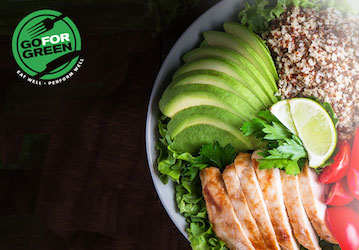For Go for Green® (G4G) color and sodium code assignments of foods as either recipes or ready-to-use (RTU) items, trained and certified G4G coders can use the Go for Green® Coding Algorithm in web-based or handwritten format. Coders enter nutrition information obtained from the nutrient-analysis printout (recipes) or the Nutrition Facts Panel (RTU items) and the ingredients list. The coding algorithm is programmed into the web-based Coding Algorithm to quicken the process by automatically assigning points to an item based on the G4G Criteria. If using the handwritten Coding Algorithm, coders add the value for each item by hand and then total the final score. Based on point values, color codes are assigned accordingly: Red (0–4 points), Yellow (5–8 points), and Green (9–13 points). For color code assignments of beverages, refer to the Beverages table.
For sodium code assignment, coders obtain basic nutrition information from either the Nutrition Facts Panel or the nutrient-analysis printout (recipes). When using the web-based Coding Algorithm, coders select the food category (for example, entrées, grains or starches, vegetables, etc.) from the drop-down list and enter the sodium amount in the Sodium Code field. If using the handwritten Coding Algorithm, coders can refer to the Sodium Criteria table for the specific food category. Menu items are then designated as Low-, Moderate-, or High-sodium foods. Beverages are not coded for sodium.
Go for Green® Coding Algorithm
|
Color Code |
|||
|---|---|---|---|
|
Nutrition Component |
Value |
Possible Points |
Points |
|
Preparation |
Is the cooking method of the product deep-frying? |
Stop here: Automatically Red |
|
|
Trans Fat |
Does the product contain “partially hydrogenated” fat/oil (trans fat)? |
Stop here: Automatically Red |
|
|
Additives |
Does the product contain added monosodium glutamate (MSG)? |
Stop here: Automatically Red |
|
|
% of calories from saturated fat |
Calculate % of calories from SATURATED fat or use nutrient analysis |
≤ 10% sat fat=2 11–15% sat fat=1 ≥ 16% sat fat=0 |
|
|
% of calories from total fat |
Calculate % of calories from TOTAL fat * Total fat may be higher than 30% and still score 2 points for select items if the saturated fat is ≤ 10%. Items that may qualify for this exception include salmon and salad dressings or condiments made with heart-healthy fats. |
≤ 30% total fat*=2 31–49% total fat=1 ≥ 50% total fat=0 |
|
|
Fiber |
Grams of fiber per serving |
> 6 grams=3 4–6 grams=2 2–3.9 grams=1 < 2 grams=0 |
|
|
Sugar |
Grams of total sugar per serving |
< 12 grams of sugar=3 12–18 grams of sugar=1 > 18 grams of sugar=0 |
|
|
Processing
|
How processed are the ingredients in the product? Mostly:
|
Mostly whole-food ingredients=3
Lightly processed, but still of moderate nutritional value=1
Moderately to highly processed and/or refined ingredients=0 |
|
|
Total Points |
|
||
|
Scoring (total points)
|
|
Sodium Code Refer to the Sodium table below to identify the appropriate Low-, Moderate-, or High-sodium code. Category Name: _________________________________ Sodium Code: ___________________________________ |
Sodium Table‡
| Sodium Content | |||
|---|---|---|---|
|
Full-plate Meal* |
< 800 mg | 800-1500 mg | >1500 mg |
|
Entree** Protein, vegetables, starch |
< 650 mg | 650-1100 mg | >1100 mg |
|
Entree** Protein and vegetables |
< 450 mg | 450-800 mg | >800 mg |
|
Entree** Protein and starch (carb) |
<600 mg | 600-950 mg |
>950 mg |
| Protein only | <350 mg | 350-800 mg |
>800 mg |
| Grains and other starches | <300 mg | 300-700 mg |
>700 mg |
| Vegetables | <150 mg | 150-400 mg |
>400 mg |
| Soup | <450 mg | 450-600 mg |
>600 mg |
| Dairy | <150 mg | 150-300 mg |
>300 mg |
| Condiments, Gravies | <200 mg | 200-300 mg |
>300 mg |
| Dessert | <300 mg | 300-600 mg |
>600 mg |
| Beverages | Will not be labeled for sodium |
| Fruits | Will not be labeled for sodium |
‡ Sodium values will be revised at three-year intervals, as more reduced-sodium products and recipes become available.
* Full-plate meal includes fruit and dairy.
**Entrees exclude fruit and dairy.
Go for Green® Coding Algorithm: Beverage Table
The Go for Green® Coding Algorithm (web-based or handwritten) shouldn’t be used to code beverages. Instead, use the following coding table. Beverages are coded based on added sugar content, artificial ingredients, saturated fat content, and healthful nutrients such as vitamins and minerals. Provide G4G educational materials to Service Members to help them make informed choices too.
|
Code |
Beverages |
|---|---|

|
|

|
|

|
|
NOTE: Use the point-based approach above to code smoothies.
*Sports drinks are coded Green when used appropriately during or after activity (or both).
